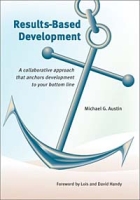| Results-Based Development: A Collaborative Approach That Anchors Development to Your Bottom Line артикул 12615d. |
 |
This book breaks new ground regarding organizational development providing a road map for business leaders to achieve ROI targets related to training & development It uses three symbols, a water treatment plant, a relay race, and an anchor chain to metaphorically represent how businesses change and grow The discussions regarding handoffs озмбн between the various stakeholders involved with development provide insights into the complexity of human performance that stretches beyond the boundaries of Performance-Based Training methodologies Each chapter follows a consistent format starting with a discussion of new elements of the Results-Based Development (RBD) process Case studies are used to demonstrate relevance of the material discussed and to furtherillustrate key messages At the end of each chapter is a list of symptoms that emerge when elements of RBD are overlooked or are being implemented ineffectively That allows you to conduct a high-level assessment of your development process as you journey through the book Chapter 1 introduces us to RBD, a four stage circular process that: * Defines business objectives, * Provides supervisor support to motivate learners before attending training, * Provides relevant training, and * Provides supervisory follow through for learners after attending training To demonstrate the collaborative effort required to achieve bottom line results from development initiatives, RBD is portrayed as an Anchor In this metaphor, the links that anchor RBD to business objectives are the unique groups of people who play primary and support roles in the RBD process Those groups are referred collectively as the target audience Performance-Based Training (PBT) strengthens the individual links in the chain by training job-relevant skills and behaviors, and by building learner confidence However, when the target audience is inadequately defined, some links in the chain can remain weakened, placing the ship, the business objectives, in jeopardy You will find that RBD goes upstream to describe gaps between current and desired states of organizational development in terms of people, processes, and technology Chapters 2-4 establish the legitimacy of taking this comprehensive approach and reinforce the need to implement integrated and multi-tiered performance solutions In Chapter 5, a performance strategy, modeled from strategies used by sales and operations, is developed to provide a framework for implementing RBD Specific requirements for each stage of the RBD process are described in Chapters 6-9, with Chapter 10 focusing on an overall implementation strategy As a supplement, the Appendix offers guidance on how to establish development standards. В книге двенадцатьISBN 0972832300. |